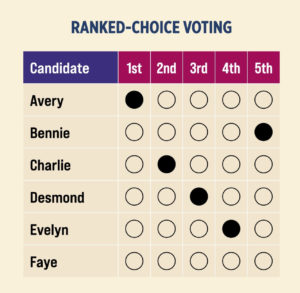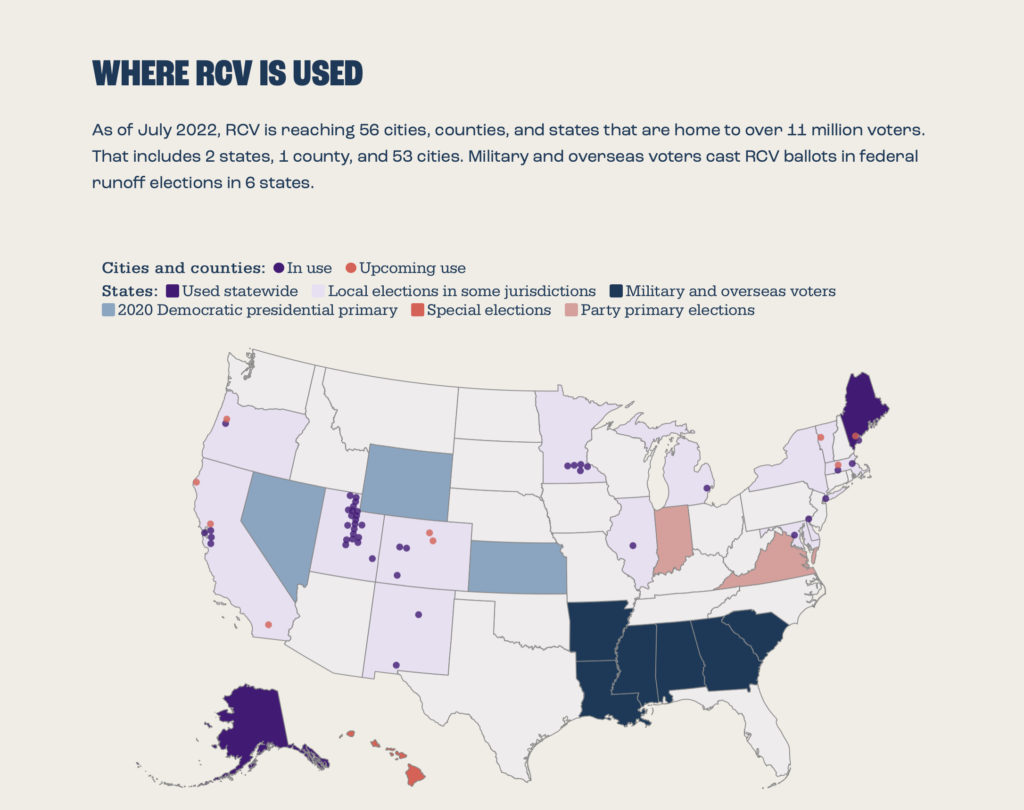Ranked Choice Voting is used increasingly around the world and in the U.S. Here’s why:
-
- When voters rank candidates in order of preference, their ballots have more power to influence the outcomes of an election.
- The election results represent the choices of more than half of the voters – and often a lot more than 50%.
- Ranked choice voting ensures that single-seat winners have at least 50% +1 votes to win in one election in November.
- Multi-winner ranked choice voting enables proportional representation. Proportional representation allows voters to elect representatives who as a group broadly reflect the interests of the people they serve. The majority is fully represented, and minorities are also represented.
- With proportional representation, groups of significant size – such as the working class, people of color, young people, renters, and seniors – have a greater opportunity to elect councilors who understand their concerns. Ranked choice voting with multi-member district elections increases the range of people and views included, making for a more equitable and effective government.
Ranked Choice ballots
-
 The ballots look the same whether they are used for single-winner or multi-winner elections
The ballots look the same whether they are used for single-winner or multi-winner elections- Voters can rank as many candidates as they like, indicating their choices up to the limit the ballot allows.
- Filling out a ranked choice ballot is easy.
- Research shows voters understand how to complete their ballots. Exit polls show 80-90% of voters understand the ranking process, even the first time. These percentages increase in subsequent elections.
Counting the votes is a job for Computers
-
- Computers sort ballots and count the votes in our elections now.
- Ranked choice vote counting will be ably handled by elections officials using security procedures and technology that must meet federal certification standards.
- Certified software to count ranked choice votes is available and reliable.
- To understand how the computers will sort and count the votes, read the explanations below and view the videos.
How Ranked Choice Votes are counted In Single-winner Elections
-
- All first-choice votes are counted first. If a candidate gets a majority (more than 50%) of first-choice votes, they win.
- If no candidate has a majority, the candidate with the fewest votes is eliminated. Votes for the eliminated candidate are counted instead for the candidates who are ranked next on those ballots.
- The process of eliminating candidates with the fewest votes and transferring their votes to the next-ranked candidates on those ballots repeats until one candidate has a majority of the votes.
- Each vote only counts once, but if a voter’s first choice doesn’t win, their vote can be counted for their second or next highest choice. This means each vote has more influence and fewer votes are wasted.
This video made by Minnesota Public Radio shows how the process works.
HoW Ranked choice votes are counted in Multi-winner Elections
The counting method used to elect more than one candidate with ranked-choice ballots is called “Single Transferable Vote (STV).” This means that although each voter has only a single vote, that vote (or a portion of that vote) can be transferred to another candidate.
The threshold – or quota referred to in the graphic below – is the lowest number of votes a candidate must receive to win a seat, so that no more candidates can be elected than there are seats to be filled.

LWVOR Election Methods Study Update 2016, p. 31. Note that threshold instead of quota is used in Portland Measure 26-228.
-
- First-choice votes on all ballots are counted first. Any candidate with more votes than the threshold is elected.
- If a candidate is elected, they keep only the percentage of votes they needed to reach the threshold. The surplus part of each vote is transferred to that voter’s second choice. If another candidate gets more votes than they need to be elected, the surplus part of each vote for that candidate also will be transferred to each voter’s next highest choice. This allows voters to be more fully represented by their choices, in proportion to their percent of the voting population. Fewer votes are wasted.
- If no more candidates have enough votes to get elected, the candidate with the fewest votes is eliminated and all votes for that candidate are transferred to those voters’ next highest choices. Then those voters also are more likely to be represented.
- This process is repeated until enough candidates are elected to fill all the open positions
With multi-winner ranked choice voting, a different set of votes elects each candidate. So when three candidates are each elected with more than 25% of the total votes, together the three winners get more than 75% of the votes. In an election for a city council, more than 75% of the voting population would be represented by city councilors they ranked among their top choices.
This video from Democracy Rising shows how multi-winner ranked choice voting works when students choose three pizzas for their party. It shows how all voters are more fully represented in proportion to their percentage of a group of voters.
